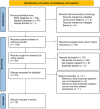Barriers to college student food access: a scoping review examining policies, systems, and the environment
- PMID: 39345250
- PMCID: PMC11428073
- DOI: 10.1017/jns.2024.25
Barriers to college student food access: a scoping review examining policies, systems, and the environment
Abstract
College student food insecurity (FI) is a public health concern. Programming and policies to support students have expanded but utilisation is often limited. The aim of this study was to summarise the barriers to accessing college FI programming guided by the social ecological model (SEM) framework. A scoping review of peer-reviewed literature included an electronic search conducted in MEDLINE, ERIC, and PubMed databases, with a secondary search in Google Scholar. Of the 138 articles identified, 18 articles met eligibility criteria and were included. Articles primarily encompassed organisational (17/18) level barriers, followed by individual (15/18), relationship (15/18), community (9/18), and policy (6/18) levels. Individual barriers included seven themes: Knowledge of Process, Awareness, Limited Time or Schedules, Personal Transportation, Internal Stigma, Perception of Need, and Type of Student. Four relationship barriers were identified: External Stigma, Comparing Need, Limited Availability Causes Negative Perceptions, and Staff. Ten barrier themes comprised the organisational level: Application Process, Operational Process, Location, Hours of Operation, Food Quality, Food Quantity, Food Desirability or Variety of Food, Marketing Materials, Awareness of the Program, and COVID-19 Restrictions. Two barrier themes were identified at the community level, Public Transportation and Awareness of SNAP, while one barrier theme, SNAP Eligibility and Process, encompassed the policy level. Higher education stakeholders should seek to overcome these barriers to the use of food programmes as a means to address the issue of college FI. This review offers recommendations to overcome these barriers at each SEM level.
Keywords: College food security; College students; Environment; Food insecurity; Policy; Systems.
© The Author(s) 2024.
Conflict of interest statement
All authors report no conflicts of interest.
Figures
References
-
- Landry MJ, Gundersen C, Eicher-Miller HA. Food insecurity on college and university campuses: a context and rationale for solutions. J Acad Nutr Diet. 2021;122:519–524. - PubMed
-
- Hagedorn-Hatfield RL, Richards R, Qamar Z, et al. Campus-based programmes to address food insecurity vary in leadership, funding and evaluation strategies. Nutr Bull 2022;47:322–332. - PubMed
-
- Hickey A, Brown O, Fiagbor R. Campus-based interventions and strategies to address college students with food insecurity: a systematic review. J Hunger Environ Nutr. 2023;18:81–95.




